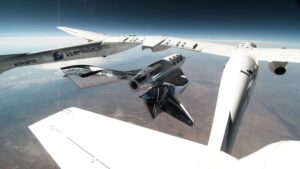The flight, with two pilots on board, will carry research payloads for NASA’s Flight Opportunities program.
“Following a detailed inspection and thorough analysis of our mothership, Eve, we have cleared our spaceflight system for our upcoming flight,” Michael Colglazier, chief executive of Virgin Galactic, said in the statement.
The schedule for that flight was put in doubt May 10, when the company said in an earnings call that it found a maintenance issue with the WhiteKnightTwo aircraft, called VMS Eve, that carries SpaceShipTwo aloft. The problem was found in checks after the plane flew a couple of flights in early May without SpaceShipTwo.
During the earnings call, Mike Moses, president of space missions and safety at Virgin Galactic, described the problem as “a potential wear-and-tear issue as requiring further evaluation and analysis” of the plane. He later described it as a “family of items that relate to fatigue and long-term stress” but didn’t elaborate on the specific components being studied.
In the new statement, Virgin Galactic described the issue as “a known maintenance item in the tail of the vehicle” that was scheduled to be handed during a maintenance period later this year. “This analysis has been completed with the company determining structures healthy, clearing Eve for flight,” the company said.
During the earnings call, company officials said they were not sure if the problem needed to be fixed earlier. If so, it would have delayed upcoming SpaceShipTwo test flights, which have already suffered extensive delays.
Virgin Galactic’s announced in February a schedule of four SpaceShipTwo flights this year, which it confirmed in the May 10 earnings call. After the upcoming flight with two pilots on board, the company will perform a second flight that will include two pilots as well as four company employees in the cabin, testing the seats and cabin features that will be used for later commercial flights.
That will be followed by a third test flight with company founder Richard Branson on board. A fourth flight will be a commercial one for the Italian Air Force, carrying several Italian payload specialists doing microgravity research. The company said in the May 10 call that the Italian Air Force flight will generate $2 million in revenue for the company.
Virgin Galactic did not offer specific schedules for the later flights beyond estimating they will be completed by this fall. Both WhiteKnightTwo and SpaceShipTwo will then go into a maintenance period lasting several months before being ready to begin commercial flights in early 2022.
The May 22 flight will be the first since a powered test flight was aborted around the time of engine ignition in December. The company later blamed that abort on the reset of a computer system on the vehicle caused by electromagnetic interference (EMI) from a new flight control computer system.
Moses said May 10 that engineers had worked to both install hardware filters to suppress the interference created by the computer as well as improving shielding on wire harnesses. That had reduced the EMI in lab tests by more than 90%.
The last time SpaceShipTwo made a powered test flight was in February 2019 from Mojave Air and Space Port in California. During that test, the spaceplane’s right horizontal stabilizer, or h-stab, was damaged because of air pressure that built up in the composite structure after technicians mistakenly covered up ventilation holes with Kapton, an incident revealed in the new book Test Gods by Nicholas Schmidle. The company did not publicly discuss that incident at the time.



